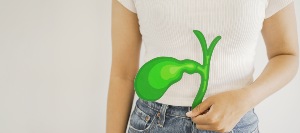Causes of Bile Duct Obstruction Q&A
Bile duct obstruction can occur due to various factors, such as gallstones blocking the bile ducts, tumors or cancers affecting the liver, pancreas, or bile ducts, and infections like cholangitis. Inflammation from conditions such as pancreatitis and bile duct strictures or scarring from previous surgeries can also contribute to blockage. At Digestive Disease Care (DDC), our team of board-certified doctors offers diagnosis and personalized treatment to effectively manage and resolve bile duct obstructions. For more information, please contact us or book an appointment online. We have convenient locations to serve you in Babylon NY, East Setauket NY, Forest Hills NY, Jericho NY, Lake Success NY, Melville NY, Mineola NY, Massapequa NY, New Hyde Park NY, and Riverhead NY.


Table of Contents:
What is bile duct obstruction?
What are the common causes of Bile Duct Obstruction?
How do gallstones cause bile duct obstruction?
What are the symptoms of bile duct obstruction?
Bile duct obstruction occurs when the ducts that carry bile from the liver and gallbladder to the small intestine become blocked or narrowed. Bile is a digestive fluid produced by the liver that helps break down fats. When these ducts are blocked, bile cannot flow properly, leading to a buildup in the liver and potential damage to liver cells. This condition can lead to serious complications if not treated promptly.
• Key facts about bile duct obstruction include:
• Location of bile ducts: The bile ducts are part of the biliary system, which includes the gallbladder, liver, and pancreas.
• Bile flow blockage: Obstruction prevents bile from reaching the small intestine, causing bile to accumulate in the liver and bloodstream.
• Cholestasis: The condition where bile flow is impaired, leading to the accumulation of bilirubin (a substance in bile) in the blood, causing jaundice (yellowing of the skin and eyes).
• Potential complications: Long-term bile duct obstruction can cause liver damage, infections like cholangitis, and can even lead to cirrhosis if not managed.
Treatment for bile duct obstruction depends on the cause, and it is essential to diagnose and treat the condition early to prevent complications like liver damage, infections, or even liver failure.
Bile duct obstruction can be caused by a variety of conditions, ranging from benign to life-threatening. Understanding the underlying cause is essential for effective treatment and management.
Common causes include:
• Gallstones: Hard deposits that form in the gallbladder and block the bile ducts.
• Pancreatitis: Inflammation of the pancreas that can cause swelling or scarring of the bile duct, leading to obstruction.
• Bile duct strictures: Narrowing of the bile ducts due to scarring, which can occur after surgery or inflammation.
• Cholangiocarcinoma: Cancer of the bile ducts, which can obstruct bile flow.
• Tumors: Tumors of the pancreas, liver, or gallbladder that compress or obstruct the bile ducts.
• Infections: Certain infections like parasitic infections or cholangitis can cause inflammation and blockage of the bile ducts.
• Cysts or bile duct malformations: Congenital abnormalities or cysts that develop in the bile ducts and cause obstructions.
Bile duct obstruction can be partial or complete, and the severity of the condition depends on the cause and extent of the blockage. Prompt diagnosis and treatment are necessary to avoid complications such as liver damage or infection.
Gallstones are solid particles that form in the gallbladder and can move into the bile ducts, where they can cause an obstruction. These stones vary in size and may block the bile duct either partially or completely. When a gallstone obstructs the bile duct, bile flow is hindered, leading to a buildup of bile in the liver and bloodstream, causing a series of symptoms and complications.
How gallstones cause bile duct obstruction:
• Migration of gallstones: Gallstones that form in the gallbladder can travel down the cystic duct into the common bile duct, obstructing the flow of bile.
• Complete or partial blockage: A large stone may completely block the bile duct, while smaller stones may only cause partial obstruction.
• Bile backup: When bile cannot flow into the small intestine, it accumulates in the liver, leading to jaundice and elevated bilirubin levels in the blood.
• Cholangitis: The blockage can lead to a bacterial infection in the bile ducts, known as cholangitis, which can cause fever, chills, and abdominal pain.
• Pancreatitis: The blockage can also cause inflammation of the pancreas, known as pancreatitis, which can result in severe abdominal pain, nausea, and vomiting.
• Increased pressure in the bile ducts: The blockage increases pressure within the bile ducts, leading to further complications if not treated quickly.
Gallstones are one of the most common causes of bile duct obstruction, and treatment usually involves removing the stones, either through surgery or endoscopic procedures. If left untreated, complications like infection or liver damage can occur.
The symptoms of bile duct obstruction vary depending on the extent of the blockage and the underlying cause. Some people may experience mild discomfort, while others may develop severe symptoms. In many cases, bile duct obstruction leads to a buildup of bile in the liver, causing various systemic effects.
Common symptoms include:
Jaundice: Yellowing of the skin and eyes due to the buildup of bilirubin in the blood.
Abdominal pain: Often felt in the upper right part of the abdomen, where the liver and bile ducts are located. The pain may be sharp or dull and can worsen after eating.
Dark Urine: Caused by excess bilirubin being excreted through the kidneys.
Light-colored stools: When bile cannot reach the small intestine, it may cause stools to appear pale or clay-colored.
Fever and chills: In cases of cholangitis, the bile duct infection, patients may develop a fever and chills.
Nausea and vomiting: Often a result of the body’s reaction to bile buildup and irritation in the digestive tract.
Itchy skin (pruritus): Caused by the accumulation of bile salts in the bloodstream.
Fatigue: Due to liver dysfunction and the body’s response to the obstruction.
Loss of appetite: Often associated with discomfort and digestive issues.
If you experience any of these symptoms, especially jaundice or severe abdominal pain, it’s important to seek medical attention promptly. Early diagnosis and treatment are key to preventing more serious complications such as liver damage or infection. For more information, please contact us or book an appointment online. We have convenient locations to serve you in Babylon NY, East Setauket NY, Forest Hills NY, Jericho NY, Lake Success NY, Melville NY, Mineola NY, Massapequa NY, New Hyde Park NY, and Riverhead NY.

Check Out Our 5 Star Reviews


Additional Services You May Like

Additional Services You May Like
- Abdominal Pain
- Acid Reflux
- Barretts Esophagus
- Bloating
- Capsule Endoscopy
- Celiac Disease
- Colon Cancer Screening
- Colonoscopy
- Constipation
- Crohns Disease
- Diarrhea
- Diverticulitis
- Esophageal PH Monitoring
- Fatty Liver
- Fibroscan
- Gallstones
- Gastroenterologist
- Gastric Chest Pain
- Gluten Intolerance
- Hemorrhoid
- Hemorrhoid Banding
- Hepatitis
- Irritable Bowel Syndrome
- Lactose Intolerance
- Pancreatitis
- Polyps
- Rectal Bleeding
- Stomach
- Ulcerative Colitis
- GI Urgent Care





